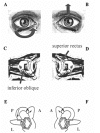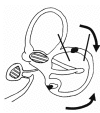Apogeotropic Posterior Semicircular Canal Benign Paroxysmal Positional Vertigo: Some Clinical and Therapeutic Considerations
- PMID: 26557364
- PMCID: PMC4627115
- DOI: 10.4081/audiores.2015.130
Apogeotropic Posterior Semicircular Canal Benign Paroxysmal Positional Vertigo: Some Clinical and Therapeutic Considerations
Abstract
We lately reported the cases of patients complaining positional vertigo whose nystagmic pattern was that of a peripheral torsional vertical positional down beating nystagmus originating from a lithiasis of the non-ampullary arm of the posterior semicircular canal (PSC). We considered this particular pathological picture the apogeotropic variant of PSC benign paroxysmal positional vertigo (BPPV). Since the description of the pilot cases we observed more than 150 patients showing the same clinical sign and course of symptoms. In this paper we describe, in detail, both nystagmus of apogeotropic PSC BPPV (A-PSC BPPV) and symptoms reported by patients trying to give a reasonable explanation for these clinical features. Moreover we developed two specific physical therapies directed to cure A-PSC BPPV. Preliminary results of these techniques are related.
Keywords: 45° forced prolonged position; apogeotropic variant; demi Semont; down beating nystagmus; positional vertigo.
Conflict of interest statement
Conflict of interest: the authors declare no potential conflict of interest.
Figures




Similar articles
-
Vertical Nystagmus in the Bow and Lean Test may Indicate Hidden Posterior Semicircular Canal Benign Paroxysmal Positional Vertigo: Hypothesis of the Location of Otoconia.Sci Rep. 2020 Apr 16;10(1):6514. doi: 10.1038/s41598-020-63630-3. Sci Rep. 2020. PMID: 32300206 Free PMC article.
-
A novel maneuver for diagnosis and treatment of torsional-vertical down beating positioning nystagmus: anterior canal and apogeotropic posterior canal BPPV.Braz J Otorhinolaryngol. 2022 Sep-Oct;88(5):708-716. doi: 10.1016/j.bjorl.2020.09.009. Epub 2020 Oct 28. Braz J Otorhinolaryngol. 2022. PMID: 33176986 Free PMC article.
-
Feasibility of Using the Video-Head Impulse Test to Detect the Involved Canal in Benign Paroxysmal Positional Vertigo Presenting With Positional Downbeat Nystagmus.Front Neurol. 2020 Oct 15;11:578588. doi: 10.3389/fneur.2020.578588. eCollection 2020. Front Neurol. 2020. PMID: 33178119 Free PMC article.
-
Apogeotropic variant of lateral semicircular canal benign paroxysmal positional vertigo: is there a correlation between clinical findings, underlying pathophysiologic mechanisms and the effectiveness of repositioning maneuvers?Otol Neurotol. 2013 Aug;34(6):1155-64. doi: 10.1097/MAO.0b013e318280db3a. Otol Neurotol. 2013. PMID: 23512075 Review.
-
Classification, diagnostic criteria and management of benign paroxysmal positional vertigo.Auris Nasus Larynx. 2017 Feb;44(1):1-6. doi: 10.1016/j.anl.2016.03.013. Epub 2016 May 9. Auris Nasus Larynx. 2017. PMID: 27174206 Review.
Cited by
-
Classification of vestibular signs and examination techniques: Nystagmus and nystagmus-like movements.J Vestib Res. 2019;29(2-3):57-87. doi: 10.3233/VES-190658. J Vestib Res. 2019. PMID: 31256095 Free PMC article. Review.
-
Atypical Bilateral Posterior Semicircular Canalolithiasis - A Case Series.Ann Indian Acad Neurol. 2024 Nov 1;27(6):720-723. doi: 10.4103/aian.aian_387_24. Epub 2024 Aug 1. Ann Indian Acad Neurol. 2024. PMID: 39083400 Free PMC article.
-
Benign paroxsymal positional vertigo - recommendations for treatment in primary care.Ther Clin Risk Manag. 2019 Jun 11;15:719-725. doi: 10.2147/TCRM.S203291. eCollection 2019. Ther Clin Risk Manag. 2019. PMID: 31354279 Free PMC article.
-
Case report: Atypical patterns of nystagmus suggest posterior canal cupulolithiasis and short-arm canalithiasis.Front Neurol. 2022 Oct 10;13:982191. doi: 10.3389/fneur.2022.982191. eCollection 2022. Front Neurol. 2022. PMID: 36299265 Free PMC article.
-
Apogeotropic Posterior Semicircular Canal BPPV-A Case Series from South Rajasthan.Ann Indian Acad Neurol. 2023 Nov-Dec;26(6):989-993. doi: 10.4103/aian.aian_706_23. Epub 2023 Sep 27. Ann Indian Acad Neurol. 2023. PMID: 38229625 Free PMC article.
References
-
- Brandt T, Steddin S. Current view of the mechanism of benign paroxysmal positional vertigo: cupulolithiasis or canalithiasis? J Vestib Res 1993;3:373-82. - PubMed
-
- Epley JM. New dimensions of benign paroxysmal positional vertigo. Otolaryngol Head Neck Surg 1980;88:599-605. - PubMed
-
- Hall SF, Ruby RRF, McClure JA. The mechanics of benign paroxysmal vertigo. J Otolaryngol 1979;8:151-8. - PubMed
LinkOut - more resources
Full Text Sources
Other Literature Sources
